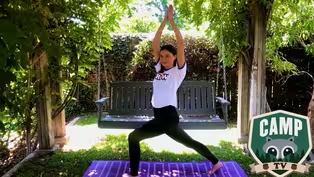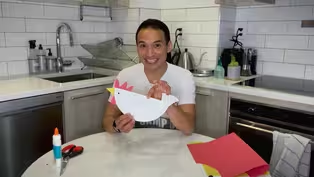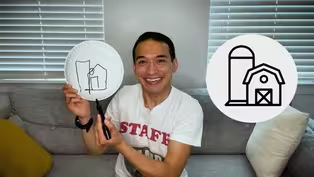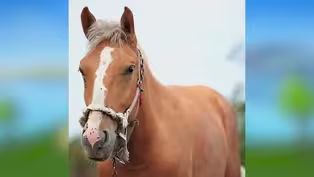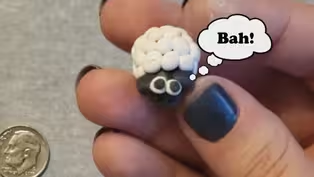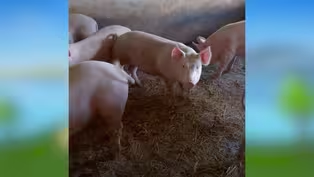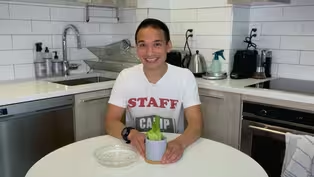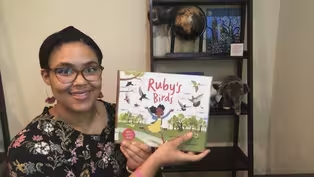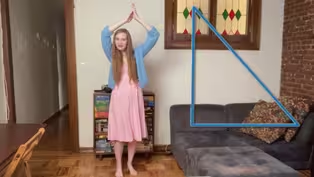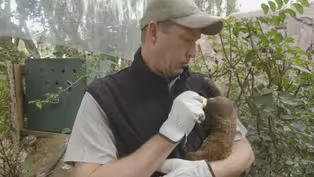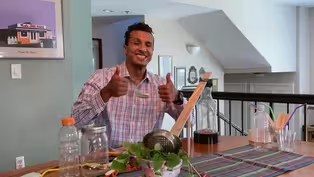
Farm Day (Long Version)
7/16/2021 | 56m 56sVideo has Closed Captions
Meet pigs and horses, regrow vegetables, make a chicken from a paper plate & a clay sheep!
Join head counselor Zach to meet pigs and horses, regrow vegetables, make a chicken from a paper plate & a clay sheep! Do a shape sort, sing about states of matter and electric cars. Content partners include Cooper Hewitt Smithsonian Design Museum, Detroit Zoological Society, GrowingGreat, NY Philharmonic, NY Public Library, One Voice Children’s Choir, S’More Ideas, They Might Be Giants.
Problems playing video? | Closed Captioning Feedback
Problems playing video? | Closed Captioning Feedback
Camp TV is a local public television program presented by THIRTEEN PBS

Farm Day (Long Version)
7/16/2021 | 56m 56sVideo has Closed Captions
Join head counselor Zach to meet pigs and horses, regrow vegetables, make a chicken from a paper plate & a clay sheep! Do a shape sort, sing about states of matter and electric cars. Content partners include Cooper Hewitt Smithsonian Design Museum, Detroit Zoological Society, GrowingGreat, NY Philharmonic, NY Public Library, One Voice Children’s Choir, S’More Ideas, They Might Be Giants.
Problems playing video? | Closed Captioning Feedback
How to Watch Camp TV
Camp TV is available to stream on pbs.org and the free PBS App, available on iPhone, Apple TV, Android TV, Android smartphones, Amazon Fire TV, Amazon Fire Tablet, Roku, Samsung Smart TV, and Vizio.
Providing Support for PBS.org
Learn Moreabout PBS online sponsorship- Hi, everybody!
My name is Zach, and welcome to "Camp TV."
Are you ready for some summer fun?
Me too!
[chuckles] Now, as your head counselor, I will be introducing you to all sorts of cool activities, arts, crafts, games, math, and science, as well as some of my favorite books, nature, and theater.
I will be here to take you from one activity to the next, so follow me on "Camp TV."
[cheerful music] - [Announcer] This program was made possible in part by the Corporation for Public Broadcasting, a private corporation funded by the American people.
Additional funding was provided by the Peter G. Peterson and Joan Ganz Cooney Fund and the Pine Tree Foundation of New York.
[bright ukulele music] ♪ Camp TV ♪ ♪ It's time for us to start ♪ ♪ From furry animal encounters ♪ ♪ To some reading and the arts ♪ ♪ No matter what the weather ♪ ♪ We'll explore it all together ♪ ♪ It's a place for you and me ♪ ♪ It's Camp TV ♪ - Hello, Camp TVers.
It is great to see you again.
Since we were last together, I did some thinking about all the incredible people in my life that I'm grateful for.
Obviously, there's you, but there's also a lot of people who spend their lives dedicated to taking care of us.
Take for example, nurses, doctors, first responders, food bank volunteers, the list goes on and on, but there's one profession I'd like to highlight today, and that's farm workers.
Those fruits and vegetables do not grow at the grocery store.
Farming is a big responsibility.
Daily care for crops and plants is essential for producing healthy food.
Many farmers also care for farm animals, and I love animals!
I mean, have you ever met a goat you didn't like [goat baas] or a cow that didn't make you smile?
[cow moos] How about a turkey's [turkey gobbles] gobble gobble that didn't make you laugh?
Feeding and watering, [chicken clucks] cleaning and grooming, [horse neighs] building and fixing are just some of the daily tasks that take place on every farm every day.
So today, I say it's time to celebrate all farmers and their farm animals too.
Welcome to Farm Day on "Camp TV."
A little birdie told me it's time to go wild!
[cheerful music] Curiosity and wonder, let's discover together.
It's Science Wow!
[bright rock music] ♪ Solid ♪ ♪ Liquid ♪ ♪ Gas ♪ ♪ Ice is a solid ♪ ♪ Water is a liquid ♪ ♪ Steam is a gas ♪ ♪ Rock is a solid ♪ ♪ Milk is a liquid ♪ ♪ And air is a gas ♪ ♪ When water's warm enough, it's a liquid ♪ ♪ When it's cold enough, it's a solid ♪ ♪ And when it's hot enough, it's a gas ♪ ♪ So could you make air so cold it would be solid ♪ ♪ Could you make rock so warm it would be liquid ♪ ♪ Could you make milk so hot ♪ ♪ It would be a gas ♪ ♪ Solid ♪ ♪ Liquid ♪ ♪ Gas ♪ Jump, dance, play.
It's time to get active.
Let's move!
- Hey, it's Sarah.
The word yoga means unity, the act of coming together, and a community is a group of people who come together because they have something in common with each other.
For example, your basic communities might be your family or your soccer team or your camp, and the really cool thing about communities is we can be part of a ton of them.
All you need is a group of people who you have something in common with.
[screen whooshes] Stand up, and we're gonna practice a pose called crescent lunge.
I'm gonna turn to the side so you can see what I'm doing.
[screen whooshes] Step one foot in front of the other.
Step your back foot a little further back so you have more space between your legs, like this.
Good!
Now, bend your knee.
And now come up to the ball of your foot so your heel is lifted.
Let's bend a little bit more into our knee.
Good, you should feel the stretch here.
When you're ready, reach your arms all the way up.
And lastly, place your palms together like this.
So now let's just hold this pose for a little bit.
Let's breathe in through our nose, [lighthearted music] out through your mouth.
[exhales] Good, bend a little bit more.
Breathe in through your nose, out through your mouth.
[exhales] You got this, keep going!
Breathe in through your nose, out through your mouth.
Okay, one more time, you got this!
Breathe in through your nose, and let it out.
[exhales] [screen whooshes] So now I want you to come back to center, and we're gonna do crescent lunge on the other side.
Step one foot in front of the other, like this.
Take your back foot and step it a little further back.
Good, now you should have a good amount of space between your legs.
Now bend your knee.
You should feel a stretch here.
Come to the ball of your foot and lift your heel.
Lift it a lot!
[giggles] And keep bending your front knee.
Good, now reach your arms all the way up.
Place your palms together, like this.
Okay, keep holding this pose, you got it.
Breathe in through your nose, and out through your mouth.
[exhales] Good, in through your nose, out through your mouth.
[exhales] Bend more into your front knee, you got this!
One more, breathe in, and breathe out.
[exhales] Keep practicing your crescent lunge, you got it!
[screen whooshes] By doing this pose, you are a part of the yoga community, so welcome!
Keep working on your community journey, and that means reach out to someone who you don't know that well and ask them what they wanna be when they grow up or what kind of music they like or who their role models are.
You can create a community with someone who you didn't think you had anything in common with, but by reaching out and communicating, you can create a community.
- Welcome back to Farm Day on "Camp TV."
Ready to get our grow on?
And no, you do not need to live on a farm to do it.
There are actually some vegetables and herbs that can be grown indoors reusing kitchen scraps.
So, the next time someone is preparing some celery or lettuce, ask if you can keep the bottom instead of them throwing it out.
Let's start with the celery.
Take the cut-off celery bottom and place it in a shallow container with some water.
The bowl should be kept in a sunny, warm place, replenishing the water as needed.
After about a week or so, leaves will begin to grow and eventually become celery stalks.
And if you prefer to get your hands a little dirty, you could always try regrowing some lettuce instead.
Place the leaves in a bowl with a little water in the bottom.
Keep the bowl in a sunny spot, and mist the leaves with water every few days.
Replenish the water as needed, and within a week or so, new roots should begin to form along with new leaves.
[gentle music] You can then transplant your new lettuce into soil.
With some patience and time, you too can enjoy some homegrown goodies.
Have fun at your next few activities.
Curiosity and wonder, let's discover together.
It's Science Wow!
- Hello, everybody.
I'm Mr. Max from GrowingGreat, and welcome to my dining room today, where we are going to try out being engineers for the day.
And what do engineers do?
They basically build and construct things that are useful, and the useful thing we're gonna try to build today is something that can water our plant from at least three feet away.
'Cause I mean, I don't know about you, but just like us, all plants need water, but you know, sometimes they are just so far away.
It's like, am I gonna go all the way over there?
No!
I mean, I can just build something that can water it for me, right?
Now, this can be pretty challenging, but I'm gonna show you in a few minutes a couple of materials, just to give you some ideas, but just to say, you can use anything you find around your house.
Whoa, okay.
Yeah, that's quite a few things we got here.
So firstly, we wanna focus on things that won't matter if they get a little bit wet since the purpose is to transport water, so we've basically got to eliminate all cardboard kind of items.
But a very important step is before we actually start building is to plan.
It's good to have a piece of paper and a trusty pencil or pen so you can sketch your ideas down.
Now again, there is no real right way to do this, and yours will look probably totally different than mine or anyone else's, but as long as it gets the job done and you just really get to challenge yourself and think about it, that's the only thing we're looking for today.
So, I'm gonna use my pencil and paper to start trying to sketch just something that may get something started for you.
[bright music] All right, think that's a pretty good place to start.
All right, so, let me go ahead and walk you through Mr. Max's watering machine, volume one.
So, I think the first thing that immediately comes to mind is gravity is probably gonna be our best friend if we're trying to get water from point A to point B.
It's a pretty good motor, and we don't have to do anything to supply it, really.
So I think obviously I'm gonna be using the yard stick to kind of be the conduit between my water and our plant.
So I think I'm gonna set up this sprinkler-headed strainer at the end of the yard stick, which I will be securing with one of our various tapes here.
And then I think to keep it propped up, we're gonna be using these chopsticks.
And, I think also I should have a dish towel underneath just in case, you know?
It's pretty considerate for our roommates, and we don't wanna get the table all wet, right?
Just in case it doesn't work like we think.
But I think this plastic bottle is going to be the top from where we put our water in, and I think this black tape actually is really solid and can be a nice base for that.
And then for actually pouring the water in, I would think it was smart that I cut a water bottle in half, so we will be pouring the water in through here, and it will be coming out of the mouth and down our yard stick.
So, I think with all that said, let's go ahead and see if it works!
All right!
Let's give it a shot.
So we got a plant all the way over here, and then we got, I'm gonna start the water right here!
Ah!
[exclaims] I mean, almost?
All right, so actually I think a surprising amount of the water stayed on the yard stick and made it to our plant, but I think it would've worked a little bit better if we had taped some kind of railing along our yard stick to keep all the water on.
That way, our plant would've definitely gotten more, and I think it would've been quite successful.
But this is a pretty good start overall.
But again, all we really want you to do is just really play around with it, and you be the engineer.
There's no right way to do it, and as long as you get water to your plant and have fun doing it, that's all we could ask for.
- [Zach] Arts and crafts?
Yes, please!
Let's Get Artsy!
- Hi, campers.
This is Ashly with the Ann Arbor District Library, and today we're going to be making sheep.
The best part about this craft is all you're gonna need is a little bit of black and white clay or Play-Doh.
So whenever you're ready, let's get started.
[sheep baaing] [whimsical music] [sheep baas] - [Zach] Music, dance, magic, and more!
Step right up to Center Stage.
- Hello, everyone!
I am Dr. Shelley Monroe-Huang, a teaching artist at the New York Philharmonic.
Today we are going to look at how you can take everyday items around you and use them to create rhythm and music.
So, let's get started with some things I have at home.
[lively bassoon music] Music is full of short and long sounds.
When we combine short and long sounds, we get rhythm.
Let's experiment with three short sounds and three long sounds.
What types of rhythms can we create when we mix up shorts and longs?
This rhythm would be short, short, long, short, long, long.
Let's try another one.
Long, long, short, short, long, short.
Long, short, short, short, long, long.
Short, long, long, long, short, short.
[lively bassoon music] We can also add a contour to our rhythm.
Contour is the shape music makes as notes get higher and lower.
So, let's do a very simple contour to start.
I'm starting off with some low notes, and then adding some high notes in the middle, almost like we're going up a mountain and coming back down the other side.
This rhythm and contour would sound like this.
♪ Short, long, long, long, short, short ♪ Let's try another one.
♪ Short, short, long, short, long, long ♪ ♪ Long, long, long, short, short, short ♪ Let's try one more, ♪ Short, short, short, long, long, long ♪ Let's listen to how the composer Nicolas Ruiz Espadero does it.
[lively bassoon music] Wow, did you notice that the rhythm really changed when you change the orders of the shorts and longs?
And, did you notice the music flowed when we added contour?
Some notes higher and some notes lower.
Well, I'm gonna play a full melody for you now You've been learning the beginning of this melody or main musical idea, and it's by a Cuban composer called Nicolas Ruiz Espadero.
The piece is called "Grande Fantaisie Cubaine," the "Grand Cuban Fantasy," and I'm gonna be playing it on my instrument, the bassoon.
So as you listen, I want you to pay attention to two things.
One, can you follow along with the rhythm, the pattern of shorts and longs?
And two, can you follow the contour, with high pitches and low pitches?
[lively bassoon music] Now that you've heard the melody, we're gonna listen to it again, but this time there's gonna be another part playing at the same time, and it's gonna have a different rhythm and a different contour.
[lively bassoon music] Now this is my challenge to you.
Can you take items from home, create your own rhythm made up of shorts and longs, and also add a contour with the notes going up and down?
Let's go through the steps together.
First, gather items from home.
Gather anything that could represent shorts and longs.
Shorts could be sticker, Legos, confettis, erasers, paper.
Longs could be paintbrushes, Popsicle sticks, pencils, string, tape, or maybe you have other ideas.
Next, arrange these items in an order to create a pattern of shorts and longs.
This is your rhythm.
Now say your rhythm.
Short, short, long, short, long, short, short, short, long.
Add contour to your rhythm.
You want to have higher notes or higher pitches and lower notes or lower pitches.
This lineup, I'm starting high, and I'm kind of bouncing down to a bottom and coming back up.
Now try to sing your rhythm with the contour.
Have your voice go up for higher pitches and go lower for lower pitches.
♪ Short, short, long, short, long ♪ ♪ Short, short, short, long ♪ Alright, happy creating everyone, good luck!
- [Zach] Ready for some math that counts?
Count On!
- Hi, everyone.
My name's Norah, and I'm gonna show you one of my favorite math games to play at home.
This game is called Shape Sort.
For this game, you need just yourself and maybe a friend.
Today, we're all gonna play together.
Here's how the game works.
I'm gonna show you a shape, and then we're gonna do a different action, depending on what type of shape you see.
All of these shapes are going to be polygons, which means that they're flat, or two-dimensional, and they all have straight sides.
Polygons are closed shapes, which means that there are also no gaps or openings in any of the sides.
Did you know that polygons have different names, depending on what type of shape they are?
The different types have different numbers of sides.
Let's do a quick review.
Polygons with three sides [bell dings] are called triangles.
Polygons with four sides [bell dings] are called quadrilaterals.
Polygons with five sides [bell dings] are called pentagons.
And polygons with six sides [bell dings] are called hexagons.
There are polygons that have seven sides, eight sides, nine sides, and 10 sides, and even more, that all have their own names too, but for this game, we're just gonna use those four.
Now, all we have to do is assign a different action to each different type of polygon we might see.
So, for triangles, if you see a triangle [bell dings] on the screen, or a polygon with three sides, let's put our arms over our heads in a triangle like this and then move our head back and forth three times.
Now, if you see a quadrilateral, [bell dings] or a four-sided polygon, let's do hopping from one leg to the other four times.
One, two, three, four.
And if you see a five-sided polygon, [bell dings] or a pentagon, let's do five spirit hands.
One, two, three, four, five.
And for a six-sided polygon, [bell dings] or a hexagon, let's do six slides.
One, two, three, four, five, six.
All right, are you ready to get started?
All you have to do is look on your screen, see what type of polygon it is, count the sides if you're not sure, and then do the action that matches that type.
Here we go!
[bell dings] [cheerful music] I think that's a triangle.
[bell dings] A hexagon!
[bell dings] Quadrilateral!
[bell dings] It's a pentagon!
[bell dings] It's a triangle.
[bell dings] [bell dings] Hexagon.
[bell dings] Triangle.
[bell dings] Another quadrilateral!
[bell dings] Wait a second.
That's not a polygon at all!
It's not closed on the bottom.
So no action, that's not a polygon.
[bell dings] Triangle!
[bell dings] Pentagon.
[bell dings] Quadrilateral.
[bell dings] I don't think that's a polygon either, those sides are not all straight.
We did it!
You all did a great job moving and sorting those shapes.
You can play this game at home with a partner too.
All you need is to make a big stack of polygon drawings.
Make sure you include different types of polygons and shapes that have different numbers of sides.
Then, take turns with your partner being the person who holds up the pictures one at a time and the person who does the actions.
Feel free to make up your own actions and to include as many different types of polygons as you want.
Thanks for joining me, see you next time!
- Welcome back to Farm Day on "Camp TV."
I thought that last activity was pretty awesome, but now it's time for a Zach Challenge!
Okay, this challenge is going to be a little bit different.
There's no clock involved, and all I have to do is draw a picture of a barn.
Only issue is I have to draw it off the top of my head.
I'll be using a paper plate and a marker, and this is the barn I'll be trying to draw.
Let's see how well I can do.
[huffs] Here I go.
[huffs] Okay.
Okay, okay.
All right, let's start with the silo here.
Oh, boy, good, that's a silo.
Just gonna draw up a little bit, so then get the connecting barn.
[whimsical music] [squeals] Okay, and then I gotta go back to find the place where I can make the door.
The door, and then just a little bit up for the window.
[huffs] Do I dare look?
[gasps] Hey!
Besides the window, I wouldn't say that's too bad.
That looks right, right?
[chuckles] See you after your next few activities.
A little birdie told me it's time to go wild!
[bright music] - Hi, my name's Chad Summers, I'm a senior keeper here at the San Diego Zoo.
We're currently standing in front of our sloth exhibit where we recently had a baby born, and we're really excited to show you guys.
It's got a lot of personality, right now it's eating me out of the house of apples, and it's quite a pleasure to work with.
It's kinda difficult to get baby off mom sometimes.
That relationship between mom and baby is pretty tight, so it's really nice that I've been working with mom quite a bit.
She allows me to take the baby off fairly easy.
We'd like to take baby off so it'll get used to vets, vet procedures, especially if they become sick.
Temperature's a big thing with sloth, so we'd just like to get our hands on to make sure everything's going well.
[sloth squeaks] The baby's already starting to venture a little bit, but typically right around four months, three, four months, the baby will start trying to be a little more independent.
Right around the time of weaning, he will start trying to explore the surrounding area so it can kinda get used to climbing, holding on, and stuff like that.
[sloth squeaks] Most of the time, they will be in their nest boxes.
There's heaters in both nest boxes, so we make it kinda comfortable for 'em.
Once it gets dark, the sloth become a little bit more active.
They will kinda search out the bits and pieces of food that I hide for 'em.
It's really nice to see them foraging naturally.
Thanks for hanging out with me at the Sloth Exhibit today.
I hope you guys learned something, and we'll see you again very soon.
- [Zach] Curiosity and wonder, let's discover together.
It's Science Wow!
[bright music] ♪ Electric car on roads so dark ♪ ♪ To change the end, rewrite the start ♪ ♪ Electric car ♪ ♪ So good so far ♪ ♪ Electric car on verdant green ♪ ♪ Invent a turn, invent a dream ♪ ♪ Electric car ♪ ♪ The new machine ♪ ♪ Let's take a ride in an electric car ♪ ♪ To the West Side in an electric car ♪ ♪ How can you deny an electric car ♪ ♪ Won't you take a ride with me ♪ ♪ Come on and take a ride with me ♪ ♪ Electric car beside the tree ♪ ♪ Roll past the dock, roll past the sea ♪ ♪ Electric car ♪ ♪ Roll silently ♪ ♪ Electric car on roads so dark ♪ ♪ To change the end, rewrite the start ♪ ♪ Electric car ♪ ♪ So good so far ♪ ♪ Let's take a ride in an electric car ♪ ♪ To the West Side in an electric car ♪ ♪ How can you deny an electric car ♪ ♪ Won't you take a ride with me ♪ ♪ Come on and take a ride with me ♪ ♪ Not diesel, steam, or gasoline ♪ ♪ Let's take a ride in an electric car ♪ ♪ Happiness resides in an electric car ♪ ♪ You can even drive an electric car ♪ ♪ Won't you take a ride with me ♪ ♪ Come on and take a ride with me ♪ ♪ Let's take a ride in an electric car ♪ ♪ To the West Side in an electric car ♪ ♪ How can you deny an electric car ♪ ♪ Won't you take a ride with me ♪ ♪ Come on and take a ride with me ♪ Arts and crafts?
Yes, please!
Let's Get Artsy!
- Hello, I'm Ellen.
I'm a curator at Cooper Hewitt Smithsonian Design Museum.
- And I'm Kim, an educator at Cooper Hewitt.
We will show you how to design your own mini exhibition at home.
- The English word curate comes from the Latin cura, to care.
Curators care for objects.
Everybody curates, from choosing how to display objects in your home to choosing what to wear.
Here are some examples from our home.
[bright music] Look around your own house or apartment.
Where are objects that you love?
How have you arranged them?
What stories are those objects telling?
- In this video, I will share some simple steps for curating a smart and fun exhibition.
First, you need to pick a theme.
Do you have a collection you've always wanted to share?
Is there an interesting story you would like to tell?
Here are some examples: Things that are red, souvenirs from a trip, the tale of the missing earrings, or strange gifts I received throughout the years.
For today's example, I pick toys.
There are many ways I could arrange these toys to tell a different story.
I could show the wide array of robots, I could create a battle scene across genres, or I could introduce unexpected elements [dinosaur thuds] to the theme.
How will you arrange your objects.
- After you arrange your objects, consider giving your exhibition a title.
You can add labels or even graphics to your exhibition.
This example has a title and a fun typewriter font.
[upbeat music] - And here is my final exhibition design.
- At museums like Cooper Hewitt, it takes a team of people to create an exhibition for the public.
Someone like me, a curator, decides on the theme and picks the objects.
An exhibition designer designs the space.
A graphic designer creates wall graphics and labels.
An interpretation team tells the story for diverse audiences.
Conservators prepare objects to go on view.
Registrars arrange to safely ship objects to the museum.
Art handlers install the objects.
The project manager coordinates all the pieces and parts.
And security officers protect objects and the public.
Those are just a few of the experts who create exhibitions in a Smithsonian museum.
- Welcome back to Farm Day on "Camp TV."
Since that last Zach Challenge was a bit sketchy, I thought I'd make it up by creating some art you might actually be able to recognize.
Have I ever shared how much I love chickens?
I do.
They make me smile, [chicken clucks] they make me happy, they make me want one, but no chickens allowed in my apartment building, so this will have to do.
Care to make a Don't Try to Stop Him Rockin' Chicken?
You will need two white paper plates, some scissors, some red and yellow construction paper, some glue, and some googly eyes.
Take a paper plate and fold it in half.
Next, with your second paper plate, cut out a tail.
[upbeat bluegrass music] Glue it to one side of your future chicken.
Next, take your red construction paper and cut out a comb for the top of its head.
Glue it on the other side of your future chicken.
Next, cut out a smallish triangle for its beak, and glue it in between the plate.
Mm, so cute.
After that, cut out another piece of red construction paper this time for its wattle, below its beak.
Hello.
And finally, finish it off with a googly eye or an eyeball you draw on your own.
Turn your chicken right side up, and there it is, your very own Don't Try to Stop Him Rockin' Chicken.
[chicken clucks] [Zach chuckles] Music, dance, magic, and more!
Step right up to Center Stage.
[bright pop music] ♪ It's been a long day without you, my friend ♪ ♪ And I'll tell you all about it when I see you again ♪ ♪ We've come a long way from where we began ♪ ♪ Oh, I'll tell you all about it when I see you again ♪ ♪ When I see you again ♪ ♪ Ooh ♪ ♪ Dang, who knew ♪ ♪ All the planes we flew, good things we been through ♪ ♪ That I'll be standing right here talking to you ♪ ♪ About another path ♪ ♪ I know we'd loved to hit the road and laugh ♪ ♪ But something told me that it wouldn't last ♪ ♪ Had to switch up ♪ ♪ Look at things different, see the bigger picture ♪ ♪ Those were the days, hard work forever pays ♪ ♪ Now I see you in a better place ♪ ♪ See you in a better place ♪ ♪ Uh ♪ ♪ How can we not talk about family ♪ ♪ When family's all that we got ♪ ♪ Everything I went through ♪ ♪ You were standing there by my side ♪ ♪ And now you gon' be with me for the last ride ♪ ♪ It's been a long day without you, my friend ♪ ♪ And I'll tell you all about it when I see you again ♪ ♪ We've come a long way from where we began ♪ ♪ Oh, I'll tell you all about it when I see you again ♪ ♪ When I see you again ♪ ♪ Oh ♪ ♪ Oh ♪ ♪ Ooh ♪ ♪ First, you both go out your way ♪ ♪ And the vibe is feeling strong ♪ ♪ And what's small turned to a friendship ♪ ♪ And friendship turned to a bond ♪ ♪ And that bond will never be broken ♪ ♪ That love will never get lost ♪ ♪ Ooh ♪ ♪ And when brotherhood come first ♪ ♪ Then that line will never be crossed ♪ ♪ Established it on our own when that line had to be drawn ♪ ♪ And that line is what we reached ♪ ♪ So remember me when I'm gone ♪ ♪ Gone ♪ ♪ When I'm gone ♪ ♪ When I'm gone ♪ ♪ How can we not talk about family ♪ ♪ When family's all that we got ♪ ♪ Everything I went through ♪ ♪ You were standing there by my side ♪ ♪ And now you gon' be with me for the last ride ♪ ♪ So let the light guide your way ♪ ♪ Yeah ♪ ♪ Hold every memory as you go ♪ ♪ Hold that memory ♪ ♪ And every road you take ♪ ♪ Will always lead you home, home ♪ ♪ It's been a long day without you, my friend ♪ ♪ And I'll tell you all about it when I see you again ♪ ♪ We've come a long way from where we began ♪ ♪ Oh, I'll tell you all about it when I see you again ♪ ♪ When I see you again ♪ A little birdie told me it's time to go wild!
[birds chirping] [bright music] Daytime or nighttime?
It's always time for story time!
- Hi, friends.
My name is Ms. Krystina.
I'm a children's librarian at the New York Public Library.
Today's story is called "Ruby's Birds" by Mya Thompson, pictures by Claudia Davila.
"School's out.
Mom and dad are at work.
My brother, Malik, is at soccer practice.
Grandma's at her favorite spot near the window.
Alex keeps her company."
Alex is Grandma's bird.
"Things are too quiet around here."
What do you think Ruby will do?
That's a great guess!
Ruby says, "I know what to do.
I play the piano, the piece my parents say is very grown up.
I practice my dance routine, the one Malik calls stomping.
I talk with Alex in the secret language Grandma taught us.
I sing at the top of my lungs."
Do you ever make up songs too?
And I'm sure you have a wonderful singing voice.
"My neighbor Eva from downstairs hears everything.
She says from her window, 'Ruby, wanna to go to the park?'
'Yes, yes, yes, yes, yessss!'
I sing."
Do you think Ruby's excited to go to the park?
Me too!
"We pass my favorite bakery.
We pass CeCe's apartment.
We walk right past my regular park, the one with the twisty slide and the sprinklers.
I guess Eva is going to a different park.
I skip along to keep up.
I follow her all the way to Central Park, where my parents sometimes take us on Sundays when we're all dressed up.
Eva is going to the woods.
I've never been that way.
We sing made-up songs about joggers and strollers and fancy dogs."
Can you see a fancy dog?
That's right, right here.
"Bee, buzz, buzz, buzz, buzz.
Suddenly, Eva stops.
She looks up.
She is listening.
I quiet down and listen too.
What's wrong, I think and wonder.
I hear a police car, a plane, and some barking.
I tug on Eva's sleeve, but she's not paying attention.
She holds her binoculars up to her eyes."
Can you pretend you have binoculars and hold up your binoculars?
Now let's see what Eva sees.
"And she's frozen like a statue.
And then she smiles a huge smile."
What do you think Eva sees?
Well, "I guess everything's okay, so I started singing again.
'Ruby!'
Eva sighs, 'You scared him away!'
'Who did I scare away?'
I ask.
Eva flops down on a bench, flop, and I sit too.
'It's a bird I've only ever seen back at home in Costa Rica,' she says.
'He's just stopping through on his way north because this is the best patch of woods for miles around.
He's quite a singer, just like you, Ruby.
If you stay quiet, we may be able to find him again.
He's a Golden-winged Warbler.'"
Can you say warbler?
Awesome!
"I nod to Eva, and I don't say a word," says Ruby.
"Or sing a word either.
It sounds like something from a fairytale.
We move carefully, we're serious, we pay attention.
We watch for tiny movements in the leaves.
We try and try."
What do you think will happen next?
That's a great guess.
"'No luck today,' says Eva."
But now, you know what to do, Ruby.
"I sing myself to sleep as usual."
And what does Ruby see?
That's right, beautiful birds and trees in her dreams!
"On Sunday morning, I beg for a walk to Central Park.
Malik's not interested, but it's family time, so he has to come anyway."
Do you remember who Malik is?
Yes, Ruby's brother.
"We pass the bodega.
We pass the theater.
I sing my song.
My family listens along.
At the park, I lead them straight to the woods.
I'm silent, I'm serious, I'm paying attention.
I hear a rustle in the leaves.
'Shh!'
I say.
Just like Eva, I am frozen like a statue."
What do you think Ruby sees?
[gasps] "A tiny bird pops out of the leaves.
It looks one way, then the other, then right at me.
I can't help it.
I get that huge smile just like Eva's.
'Look!'
I yell.
'Ah, yes!'
says Grandma.
'I see a warblerrrr!'
I sing, as the warbler flies away."
The end.
There are lots of birds in our communities and parks and neighborhoods.
There are many types of birds that you can find if you just take a look around.
Here's a picture of the many types of birds, including warblers, that you might see.
I hope that you enjoyed today's story, "Ruby's Birds."
[cheerful music] [bright ukulele music] ♪ Camp TV ♪ ♪ It's time for us to part ♪ ♪ From furry animal encounters ♪ ♪ To some reading and the arts ♪ ♪ No matter what the weather ♪ ♪ We'll explore it all together ♪ ♪ It's a place for you and me ♪ ♪ It's Camp TV ♪ - [Announcer] This program was made possible in part by the Corporation for Public Broadcasting, a private corporation funded by the American people.
Additional funding was provided by the Peter G. Peterson and Joan Ganz Cooney Fund and the Pine Tree Foundation of New York.
Content provided by these institutions.
[cheerful music] [bright music]
Video has Closed Captions
Clip: 7/16/2021 | 3m 1s | Join Sarah from the S'More Ideas Crew for some yoga moves in this video from Camp TV. (3m 1s)
Don't Try and Stop Him Rockin' Chicken
Video has Closed Captions
Clip: 7/16/2021 | 1m 34s | Try this "Don't Try and Stop Him Rockin' Chicken" craft with Zach. (1m 34s)
Video has Closed Captions
Clip: 7/16/2021 | 1m 17s | In this challenge Zach has to draw a barn. (1m 17s)
Video has Closed Captions
Clip: 7/16/2021 | 58s | Do you love horses? We do too! Watch them gallop and play. (58s)
Video has Closed Captions
Clip: 7/16/2021 | 3m 8s | Learn how to make a teeny-tiny clay sheep with this video from Camp TV. (3m 8s)
Video has Closed Captions
Clip: 7/16/2021 | 50s | Time to go wild and debunk some pig myths. Were you surprised by any of these real facts? (50s)
Regrowing Vegetables From Scraps
Video has Closed Captions
Clip: 7/16/2021 | 1m 21s | Regrowing veggies from scraps. (1m 21s)
Video has Closed Captions
Clip: 7/16/2021 | 7m 1s | Create your own melody with household objects with this NY Philharmonic video from Camp TV (7m 1s)
Video has Closed Captions
Clip: 7/16/2021 | 7m | Krystina from the New York Public Library reads "Ruby's Birds" by Mya Thompson. (7m)
Video has Closed Captions
Clip: 7/16/2021 | 5m 18s | Play this fun math game to put your shape knowledge to the test! (5m 18s)
Video has Closed Captions
Clip: 7/16/2021 | 1m 45s | Check out how zookeepers at the San Diego Zoo care for adorable baby sloths in this video. (1m 45s)
Video has Closed Captions
Clip: 7/16/2021 | 4m 53s | Follow along to create a contraption to water a plant from 3 feet away! (4m 53s)
Providing Support for PBS.org
Learn Moreabout PBS online sponsorshipSupport for PBS provided by:
Camp TV is a local public television program presented by THIRTEEN PBS
